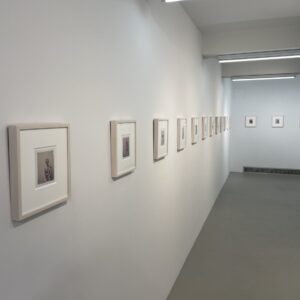JTF (just the facts): A total of 59 black and white and color photographs, variously framed and matted, and hung against white walls in the main gallery space, the smaller back room, and the entry area.
The following works are included in the show:
- 1 platinum print, 1962/1997, 15×23 inches, edition of 15
- 11 digital prints, 1966/2018, 1968/2018, roughly 12×18 (or reverse), 13×9 (or reverse), 20×29, 19×30 inches, editions of 15
- 2 chromogenic prints, 1962/2005, 13×9, 28×42 inches, edition of 15
- 7 dye transfer prints, 1962/1971, 1962/1984, 1966, 1966/1971, 1966/1984, roughly 12×18, 27×32, 25×39 inches, vintage, exhibition print or portfolio print (ed. 50)
- 17 gelatin silver prints, 1951/later, 1954/1995, 1956/2004, 1957/2005, 1959/1999, 1961/2004, 1961/later, 1965/contemporary, 1958/2005, roughly 12×18, 13×9, 14×9, 11×14 (or reverse), 17×12, 12×18, 13×19, 14×20, 15×20 inches, editions of 15 or no edition information provided
- 21 vintage gelatin silver prints, 1962, 1963, 1964, 11×14 (or reverse)
(Installation shots below.)
Comments/Context: The harrowing chaos of war is among the toughest assignments for a photographer. Not only is he or she putting his or her life on the line to get the pictures, the intensity of the action demands a constant stream of split second photographic decision making. That photojournalists have repeatedly come away with memorable visual documentation of dangerous conflicts across the globe is certainly a celebration-worthy accomplishment in and of itself. And when those pictures consistently rise to the level of art, another level of acknowledgement seems necessary.
Larry Burrows had already been working for LIFE for the better part of two decades (first as a lab technician during World War II and later as photographer on assignment) when the opportunity to cover the war in Vietnam came through. And from his first efforts in 1962 all the way through to his death in a helicopter crash over Laos in 1971, Burrows brought a dependable sense of engaged humanism to the seemingly far away abstractions of policies, strategies, battles, and deaths tolls.
This show gathers together an eclectic grouping of Burrows’ work, including vintage prints in black and white from the LIFE archives, dye transfers from a posthumous portfolio, and recent digital prints in color made from the original transparencies, with images from various battle assignments hung in the main gallery space.
A pair of these new enlargements shows off Burrows’ talent for framing action. One memorably captures an ammunition airlift taking place over Khe Sahn in 1968. As the helicopter descends carrying its precariously hanging cargo, a golden waft of smoke arises from the dark hellscape below, a lone red flag jutting up into the grey sky with a sense of defiant get-it-done persistence. That sense of optimism also underlies an image of a side-gunning Puff the Magic Dragon C-47 airship over the Mekong Delta in 1966. As the gunners fire away, a torrential blast of orange flame erupts into the air, the whole view tilted on an angle like an amusement park ride.
But Burrows’ real photographic talent was more consistently found closer in, where the faces and gestures of individual soldiers could be seen with more clarity. With the wash of the rotors flattening the long grass around him, Burrows took two poignant images of soldiers recovering the bodies of the wounded. The faces of those carrying their comrades mix anguish, exhaustion, and the strain of effort, while the bodies of the injured are carried in poses reminiscent of the crumpled form of Jesus – bent, draped, or cradled like a pieta. The pictures freeze the action in ways that are reminiscent of the careful arrangement of religious paintings, all within the frenetic rush of transporting friends under fire.
Back in camp, Burrows’ genuine interest in the lives of the soldiers shines through. He sees the dirt, sweat, and frustration of the first failed attempt to capture Hill 484. He notices the thick mud that forms the ground of a first aid station. He watches as wounded soldiers reach out to each other in baffled recognition that they are still alive. He documents anxious hands-held prayer services and communion before battle. And he captures the far away look in the eyes of a soldier near the DMZ, the emotions on his face a microcosm of the entire war.
Burrows’ 1965 photo essay One Ride with Yankee Papa 13 combines all of these threads into one self contained story. Heading out on a mission to airlift an infantry battalion, an easy going, smiling young man carries his guns to the helicopter, and is later seen with his helmet on, peering out into the open air. But when they arrive, things go sideways, and a harried firefight ensues, with wounded (and presumably dead) bodies tossed in piles inside on the metal floor. Calm confidence transitions to fear and horror before our eyes, as the young man’s face recoils at the carnage before him. Burrows’ last shot in the sequence tracks the soldier back to his barracks, where he breaks down in tears, bent over his foot locker. For those back home, this vignette was the kind of truth telling and nuanced emotional reporting that gave an honest picture of what was really happening in Vietnam.
Even for veterans and military buffs, Burrows’ images aren’t necessarily the kind of pictures to hang on the wall of one’s home – they carry too much raw emotional weight to comfortably encounter on a daily basis. But as documents of the human realities of the Vietnam War, they rank among the richest and most empathetic photographs made during the conflict. Burrows consistently found humanity in places and situations that actively threatened to extinguish it, and those sensitive discoveries retain their resonant power even half a century later.
Collector’s POV: The works in this show range in price from $3500 to $35000, with one print POR. Burrows’ work has only been intermittently available in the secondary markets in the past decade, with prices ranging from roughly $1000 to $19000.



























